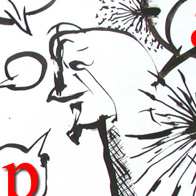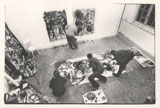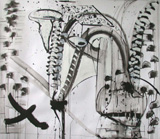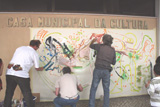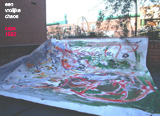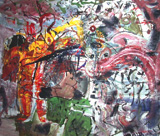| |
|
| |
|
| |
|
| |
|
 |
| |
|
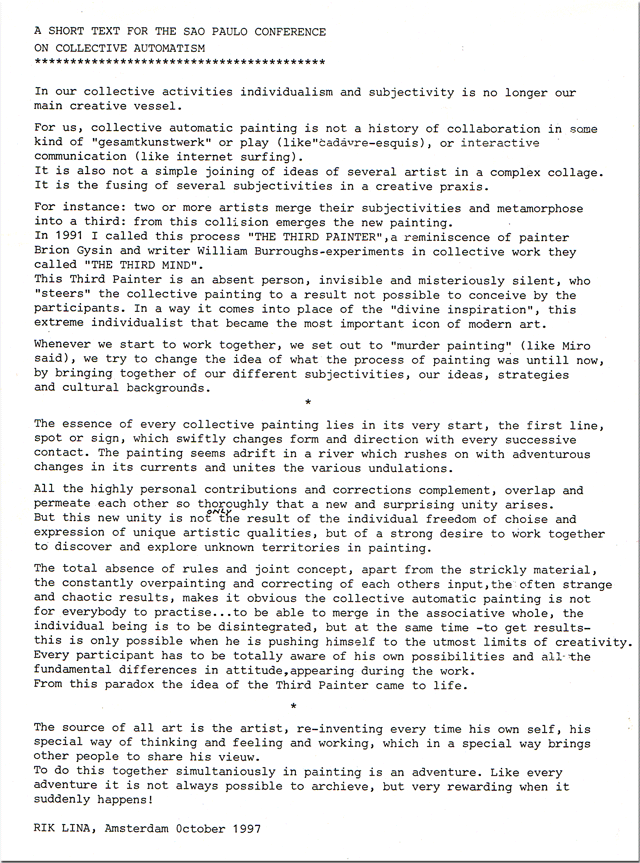 |
Automatisme collectif et désirs sans limites (1995)Rik Lina (Pays Bas 1942)(traduit en français par E. Malres) Publié en: "Superieur Inconnue" Numero Spécial sur le désir (2009) Redaction: Sarane Alexandrian. Un domaine sans poteaux indicateurs Qu'est-ce qui amène un artiste à vouloir oublier toutes ses idées personnelles et à expérimenter avec des automatismes collectifs ? L'individu qui travaille de façon automatique prend son matériel par curiosité de ce qui va venir. Un collectif d'artistes qui travaille de façon automatique fait la même chose mais en commun. Tous travaillent à une seule toile. Il faut d'ailleurs clairement faire la distinction entre un groupe qui opère en tant que collectif et le travail en groupe plus courant où des idées qui ont été élaborées à l'avance sont développées. Un automatisme pur n'est possible que dans la première catégorie puisqu'il n'y a pas d'autre but, projet ou concept que de travailler ensemble. J'ai fondé en 1989, avec quelques esprits du même bord, la revue Droomschaar qui était une plate-forme pour un conglomérat international et très divers d'afficionados de tendances surréalistes, anarchistes et situationnistes, bref libertaires. C'est ainsi que je rencontrai en 1990 le peintre Fredy Flores Knistoff (Chili, 1948). Très vite, nous découvrîmes que nous avions une passion commune pour la peinture automatique, que nous avions tous deux déjà pas mal d'expérience en matière de peinture collective et que nous habitions tous deux à Amsterdam. Nous décidâmes sur le champ de travailler en commun. Pendant l'été 1991, Fredy et moi, nous avons inauguré notre expérience de peinture collective automatique. Nous ramassions des objets présents sur place au hasard et nous nous mettions à peindre en même temps sur la même toile sans se concerter à l'avance ou pendant le travail. Il n'y avait pas de pauses ou de discussions. Après environ une demi-heure nous arrêtions le travail de façon aussi abrupte que nous l'avions commencé. Belle ou pas, la peinture était finie et nous en commencions une autre. Après avoir réalisé de cette façon plusieurs oeuvres, nous vîmes que nous obtenions à chaque fois quelque chose de totalement différent. De loin, cela ressemblait quelque peu à ce que l'un d'entre nous faisait mais l'oeuvre différait néanmoins mystérieusement de ce que nous aurions réalisé de façon individuelle. Chaque peintre développait ses propres méthodes de travail. Nous les unissions dans cette action en commun, mais c'est comme s'il se passait plus de choses que la seule accumulation de nos méthodes. Comme si une troisième personne, qui aurait eu sa propre contribution à l'oeuvre, était présente. Nous avions tous deux la forte impression que la peinture posait ses propres conditions, et se chargeait elle-même en quelque sorte du travail. Nous baptisâmes cette impression the third painter en reconnaissant que ce peintre était influencé par Cobra, ce qui ne pouvait être affirmé à propos de nos tableaux personnels. Nous poursuivîmes notre expérience les semaines suivantes. Le résultat ne comptait pas. Nous voulions avant tout assouvir notre curiosité concernant le processus, concernant ce qui se passait lors de ces enchaînements, aussi rapides que l'éclair, de stades qui se superposent et qui se mordent. Les collisions inévitables, le fait de repeindre sans gêne par-dessus le travail de l'autre, les changements surprenants de croisières et l'imprévisibilité du parcours : tout cela nous fascinait. C'était une expérience extrêmement étrange et excitante de pouvoir de cette façon dépasser les frontières de l'individualisme et de pouvoir coordonner nos méthodes de travail individuelles. Notre enthousiasme ne fit que croître lorsque nous décidâmes d'élargir notre expérience en invitant chacun un ami. Fredy convia Miguel Lohlé (Argentine, 1952), un peintre avec lequel il avait déjà travaillé, et personnellement je choisis le dessinateur et créateur d'installations Dave Bobroske (Canada, 1949), avec qui je réalisais déjà depuis quelque temps un cadavre exquis par correspondance. Puisque le travail à quatre demandait plus de place, nous avons pris une toile d'un format plus grand. La vitesse de travail fut augmentée à cause du déluge d'interventions qui devaient trouver place simultanément, ce qui menait parfois à des collisions amusantes. Combien de fois n'est-d pas arrivé que je voulais changer quelque chose et qu'un autre avait eu la même idée juste avant moi! Une véritable bataille de peintres se déroulait au-dessus des grandes toiles. Lorsque deux personnes travaillent ensemble, d y a une forme de dialogue dans le travail en commun. Il n'y a irrévocablement pas de possibilité d'un tel dialogue dans le travail de groupe. Nous étions créateurs et spectateurs dans une danse autour de la toile. Peindre devint une expérience spatiale. Quelques mois plus tard nous élargissions nos sessions avec encore trois autres artistes. Ils provenaient, tout comme Lohlé, Bobroske, et Flores-Knistoff, du cercle de Droomschaar et tous - chacun sur son terrain - avaient pratiqué les techniques automatiques. Je connaissais Gerda van der Krans (Pays-Bas, 1947 : sculptures et installations) et le poète-compositeur Paul Goodman (Canada, 1955) des performances du groupe MIDIM, où j'avais vu travailler Dave pour la première fois. Je connaissais aussi le poète et artiste graphique Geert van Mulken (Pays-Bas, 1947), de l'époque de Brumes blondes (1963-1976), la seule revue internationale et purement surréaliste qui ait existé aux Pays-Bas. Les sessions : la peinture automatique collective en neuf points. 1. Nous ne faisions pas de projets en ce qui concernait la stratégie à suivre. Il n'y avait pas de plan. Le seul point de départ était : travailler en même temps à une oeuvre de façon automatique. 2. Nous utilisions en général un papier ou une toile de grand format que nous posions par terre, afin que tous les participants puissent travailler dessus en même temps. Nous utilisions de la peinture acrylique, car la peinture à l'huile n'est pas très pratique à cause du fait qu'elle sèche lentement, même si nous devions aussi attendre de temps en temps avec la peinture acrylique. Les couleurs principales étaient en général préparées à l'avance, mais quelquefois nous les faisions également en cours de route. D'autres techniques - tels que le collage et le lavage - et d'autres matériaux (toujours là par hasard), tels que des textes, des chaussettes, de l'encre, du sable, etc. pouvaient être utilisés impulsivement. Auparavant, nous mettions souvent de la musique. 3. Tous les participants commençaient toujours à travailler en même temps. Durant le travail personne ne parlait, ou à peine, et certainement pas à propos du travail Personne ne se comportait en tant que meneur ou avait la possibilité de se comporter en tant que tel. Chaque attitude de ce genre était négligée ou transformée en son contraire. 4. Les travaux s'arrêtaient en général par eux-mêmes après une demi-heure, puis nous nous concertions pour savoir si tout le monde trouvait qu'il était terminé. A cette occasion également, personne n'avait la possibilité de s'afficher comme meneur de la troupe. 5. Lorsque pendant une session suivante nous travaillions de nouveau sur une toile, avec les mêmes ou différentes personnes, nous parlions d'une modification. La place, la date et le lieu étaient rajoutés au dos de la toile. 6. Les deux premières années (1991-1992) les sessions avaient lieu toutes les semaines dans mon atelier à Amsterdam. Plus tard, c'était tous les mois. Une fois ou deux nous travaillions dans l'atelier de quelqu'un d'autre, parfois plusieurs jours d'affilée. La continuité de nos travaux fut interrompue après trois ans. Nous ne recommencions plus que lorsque quelqu'un d'entre nous en ressentait la nécessité et rassemblait les autres participants. 7. Il n'était pas nécessaire que tous les participants soient présents à toutes les sessions, même si c'était possible. Ceux qui étaient présents travaillaient. Quelquefois il n'y en avait que deux, en général quatre ou cinq, et à plusieurs reprises le groupe entier de sept personnes. 8. Les poètes dans le groupe écrivaient des textes à côté et dans la peinture. Au début nous découpions des lettres ou des textes imprimés de journaux et autres et nous les collions sur la peinture ou bien nous travaillions avec des pochoirs. Plus tard les textes étaient peints directement dans la toile d'où la création de peintures-mots. 9. Les résultats de nos expériences ont été exposés à plusieurs reprises. Durant des vernissages nous avions des sessions de performances auxquelles d'autres amis peintres participaient également. Un automatisme pur y était toujours possible, mais l'attention passa de la peinture au théâtre. Parfois nous nous laissions guider par des musiciens improvisateurs ou nous travaillions dans l'obscurité, tandis qu'un artiste-vidéo utilisait notre toile verticale comme toile de projection. |
| |
|
| |
|
| |
|
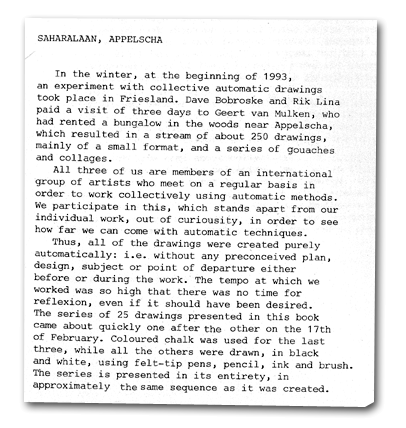 |
| |
|
Een vrolijke chaosToen ik bij Dave Bobroske aankwam was Geert van Mulken net gearriveerd. Hij kwam vanuit Den Haag naar Utrecht, Fredy Flores Knistoff, Miguel Lohlé en Mauritio Jalil kwamen een trein later dan ik uit Amsterdam. Toen Gerda van der Krans uit Nijmegen kwam was het eerste collectieve werkstuk al gemaakt.Mauritio's foto's van deze sessie geven een goede indruk van de "schilders-razernij"die ons in zijn greep kreeg. Dave's flat leende zich hier eigenlijk helemaal niet voor, wij liepen elkaar behoorlijk in de weg, maar toch ging het werk uitstekend. Na een paar uur lag het vol drogende schilderijen: de gang, slaapkamer, douche-ruimte en zelfs buiten op het bordes. Nadat de rol papier op was haalde Gerda enkele grote werken tevoorschijn die zij een jaar tevoren, tijdens een MIDIM-performance in het Amsterdamse Stedelijk Museum had "besneden": langs de randen waren inkepingen aangebracht die een omkrullend reliëf vormden. Terwijl wij deze meterslange bladen bliksemsnel van onze tekens voorzagen, in alle kleuren van de regenboog, sneed Gerda er met een vlijmscherp mes nieuwe vormen in uit, op deze wijze Miguel tot wanhoop drijvend, die met een rol plakband achter haar aankwam om de sneden dicht te plakken…Dave schilderde over het plakband heen en ik trok het er vervolgens weer af, zodat er een grillig patroon ontstond. De door Fredy met kracht geworpen verfsporen bedekten al snel, behalve het werk, ook de muren en het plafond! Terwijl het donker werd werkten wij voort met toenemend enthousiasme. Kon er in het begin nog van enige esthetische consideratie gesproken worden - die was die nu helemaal verdwenen: het laatste schilderij kreeg zelfs geen kans om te drogen…steeds wanneer iemand waagde voor te stellen dat het voltooid was werd het onmiddellijk opnieuw onder handen genomen…gestart als een collectieve modificatie van Gerda's werk, ontstond er toen een voortdurende modificatie: een metamorfose van vormen, kleuren, stemmingen en gevoelens. Deze herhaaldelijke aanval op het zojuist ontstane schilderij, met als gevolg dat dit onherkenbaar wordt veranderd - en soms zelfs verdwijnt - stelt hoge eisen aan het ego…men zou zich kunnen afvragen: hoe is dit vol te houden zonder ruzie? Het vreemde is echter dat elke ingreep met enthousiasme wordt begroet: dit schilderij schept zichzelf! Iedere keer wanneer wij samen aan de slag gaan zijn we nieuwsgierig naar wat er nu weer tevoorschijn kan komen. Dit gevoel van verwachting, van verrast te willen worden heeft iets feestelijks: er staat iets te gebeuren waarvan nog niets bekend is, iets waarover men kan dromen, iets dat zelfs niet aanwezig kan zijn in de verbeelding, iets dat pas door onze gezamenlijke ontdekkingen - die in hoog tempo en op volstrekt onvoorbereide wijze plaatsvinden - tevoorschijn wordt getoverd. Deze keer waren de resultaten bijzonder wild. De razende verfmassa riep zoveel vormen op: suggesties van landschappen, steden, dieren, personages, geesten, duivels of goden. Miguel, door hallucinaties overmeesterd, riep zich uit tot de "Third Painter". Deze door mij in een theoretisch artikel voorgestelde "andere", onzichtbare schilder die, wanneer wij samenwerken, het werk van ons "overneemt", is de denkbeeldige figuur die het schilderij haar definitieve vorm geeft; want deze uiteindelijke beeldbepaling is er altijd een welke door geen van ons apart kan worden bedacht. Even later was het een driemanschap: Gerda - Miguel - Rik - om beurten elkaar snel afwisselende hetzelfde penseel hanterend - dat zich tot deze mysterieuze figuur uitriep! Zo kon er deze dag van een echte schildersroes gesproken worden en dat was niet alleen het gevolg van onze automatische werkwijze. De tien grote schilderijen die wij maakten verkennen in heldere kleuren een onbekend en verrassend vrijgevochten innerlijk landschap. Non-stop werkend van half drie tot een uur of elf. Af en toe was er iemand aan te treffen in de keuken, in de weer met een bakpan of een fles wijn. Naar de resultaten werd nauwelijks omgezien. Het was het werken zelf dat ons fascineerde, dit onafgebroken creatieve gesprek met elkaar door middel van de materialen, de experimenten en de vondsten - en de reacties daarop, vaak door verscheidene mensen tegelijkertijd uitgevoerd. Dit is het werk van de kunstenaar die aan zijn atelier ontsnapt en met zijn of haar ideeënwereld "in de ring stapt" en zo de dialoog met de anderen aangaat - zonder enig overleg vooraf, zonder af te spreken waarover het zal gaan en zonder dat iemand de leiding neemt. En zonder conclusie, want het is de chaos zelf die wordt opgeroepen: een absurde chaos, maar wél een die inspireert en - vóór alles - vrolijk maakt. Een gebeurtenis waarbij het gevoel, de emoties en de ideeën direct worden uitgedrukt in verf en omgezet in een ongeordend terrein van ongekende mogelijkheden. Elke schilder is maker en beschouwer tegelijk, maar volgt nu de elkaar kruisende en overlappende sporen van zijn companen waarin een "niet persoonsgebonden creatie" verrassend vorm aanneemt. De bezeten werkwijze van deze sessie is natuurlijk niet de enige weg, al zal elk werk dat op spontane, automatische wijze tot stand komt iets van "bezetenheid" bezitten. Tijdens andere sessies gaan wij rustiger te werk, meer bedachtzaam, maar steeds wanneer wij merken met iets bezig te zijn wat lijkt op iets dat wij al eerder maakten, doorbreken wij deze richting en veranderen van koers, veranderen het werk desnoods destructief, want ieder nieuw begonnen ding zal immers een sprong zijn in het onbekende? De poorten van het collectief onbewuste staan wijd open. Je zou kunnen stellen dat wij bezig zijn onze onbevangenheid te cultiveren, was het niet dat voor ieder van ons de automatische werkwijze een vaste plaats in het persoonlijke werk inneemt. Toch willen wij spontaan en "onervaren" blijven. Het concept is de aartsvijand van de poëzie. Wij wensen ons niet door onze ervaring te laten leiden, ons de wet te laten voorschrijven door een intelligente, rationele of esthetische benadering. Wij willen samenwerken op een terrein waar tot op nu slechts voor één persoon plaats was. Dit "terrein zonder wegwijzers", dat wij steeds opnieuw, benieuwd en verwachtingsvol betreden, is een chaos waar de elementen nog ongevormd lijken te bestaan en dat door onze gezamenlijke ingrepen in voortdurende metamorfose blijft. De gebruikelijke ideeën over kunst of esthetiek staan hier zelfs niet ter discussie. Wij zijn op zoek naar nieuwe. Rik Lina (Utrecht, november 1992) |
| |
|
| |
|
| |
|
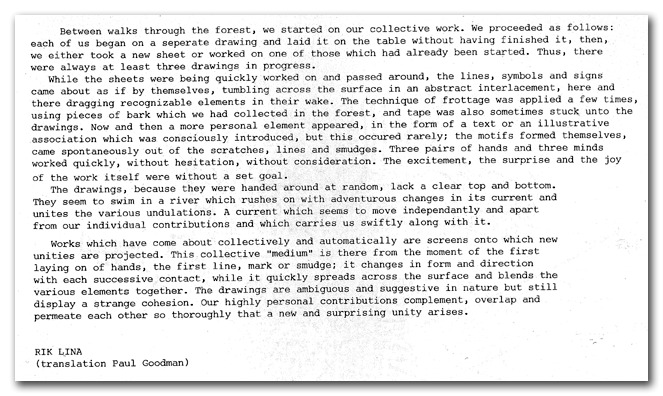 |
| |
|
